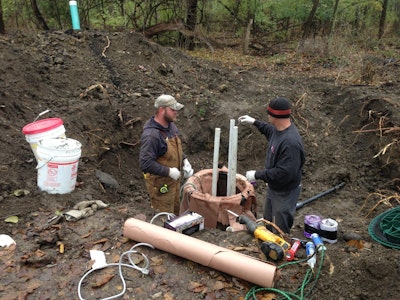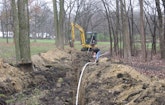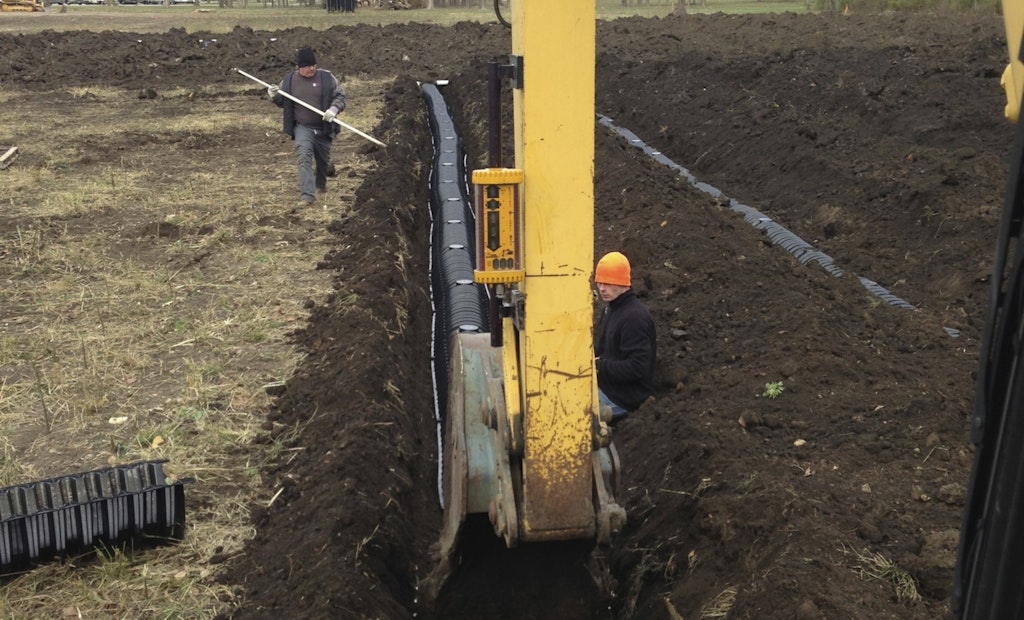Interested in Septic Tanks?
Get Septic Tanks articles, news and videos right in your inbox! Sign up now.
Septic Tanks + Get AlertsMembership was increasing at Leisure Lakes Resort in Joliet, Ill., and the owners wanted to treat the park's wastewater rather than store it in concrete holding tanks, one for each of three recreational vehicle campsites.
Of the 235 pads, 163 discharged to three holding tanks in series: capacities 6,000 gallons, 3,000 gallons, and 1,500 gallons. Zeiter's Septics Unlimited in Morris pumped the tanks weekly from April to December. Since the company also designed and installed onsite systems, the resort owners hired president David Zeiter to find a solution.
"Initially, we thought a conventional system could treat the waste," says Zeiter. "But once we saw the soil loading rate and the design and holiday flows, we switched to an aerobic unit that allowed us to reduce the drainfield from 10,500 to 7,000 linear feet." The only area for the system was more than 1,000 feet from the holding tanks between two gas lines and a forest.
While state code specified a 11,250 gpd aerobic treatment unit (ATU) to treat the expected peak flow, Zeiter's design specified a 9,000 gpd unit and received approval from the county after hiring Huff & Huff Engineering in Oak Brook and having a licensed engineer stamp the plans. Despite the presence of water mains, power lines, and the 24- and 36-inch gas mains in their path, the four-member crew installed the system without damaging any utilities.
Site conditions
Soils were fill material and orthents (well-drained soil of medium to fine texture, usually above shallow bedrock and lacking evidence of horizonation). The loading rate was 0.27 gpd per square foot, and the water table lay 60 inches below grade. The DuPage River forms the west property boundary.
System components
Zeiter designed the system to treat a peak in-season flow of 11,250 gpd. Major components were:
- Existing holding tanks, each with duplex 2-inch sewage pumps (Goulds Water Technology)
- 3,000-gallon single-compartment concrete septic tank with SaniTEE wastewater screen (Bio-Microbics). All tanks from Wieser Concrete, Maiden Rock, Wis.
- 10,000-gallon concrete tank with MicroFAST 9.0 treatment system (Bio-Microbics)
- 3,000-gallon, single-compartment, concrete dose tank with five 1/2 hp effluent pumps (Liberty Pumps)
- Arc 24 chambers (Advanced Drainage Systems) in a 290- by 310-foot drainfield
- Custom-built control panels from Ohio Electric Control, Ashland
System operation
Wastewater flows through 4-inch laterals and sanitary mains, one per holding tank. On-demand alternating pumps in the tanks send 75 to 100 gallons to the septic tank. An 8-inch SDR-35 PVC pipe in the tank outlet connects to the ATU. Liquid passes through the filter in the pipe before entering the treatment tank.
Submerged fixed-film technology and passive recycle treat the flow and maintain microbial growth during low, average and peak usage. The combination also improves sludge settling and eliminates sludge bulking. A sequencing fixed reactor allows the blower to cycle at predefined intervals, potentially reducing energy costs up to 50 percent and, in some instances, enhancing nitrogen reduction.
From the treatment unit, effluent flows to the dose tank, where alternating pumps send 2,000 gallons to each of five zones in sequence. "During high flows, the control panel will activate a second, third or all the pumps as needed," says Zeiter. "In the real world, five running at once should never happen." The flow scours the piping, making backflushing unnecessary.
Installation
"I was very concerned with locating all the utilities," says Zeiter. "The two men in charge of the facility knew where most of them crossed our path, but we still needed a locate – call before you dig – to help with the power lines." Workers also charged some water pipes and traced them using RD400 locators (Radiodetection). They hand-dug to verify utility locations, including the two gas lines separated by 18 inches.
While waiting for the tanks to arrive, the crew laid out the grid for the drainfield and shot grades with lasers (Leica Geosystems). The serial system dropped 3.5 feet from the beginning of the first zone to the end of the last zone. A Depthmaster MC200 laser alignment tool (Leica) on the Komatsu excavator helped keep the trenches level.
Workers installed a header manifold down the center of each zone with 29 laterals running 100 feet on 9-foot centers on both sides. "We laid out four 290- by 210-foot zones before running out of room because of the sheer drop off and river 200 feet away," says Zeiter. "The fifth zone was 10 feet to the south with 14 100-foot laterals."
The crew left one-third of the drainfield unfinished, enabling the crane and delivery truck to reach the tank excavations. Without existing plumbing to dictate the depth of the tanks, Zeiter set them as shallow as possible.
The tanks arrived in halves with TW-Risers by Infiltrator cast into the lids and 1.5-inch rubber boots in the ends to accept piping. The precaster also mounted the ATU to the bottom of its tank. Workers set that tank 12 inches above grade, then used its elevation to determine the depth of the septic and dose tanks. They bedded the excavations with 6 inches of 3/4-inch stone.
"We installed a union on the 3-inch air line that enables us to remove the blower at the end of the season and store it in a heated shop until spring," says Zeiter.
While his crew set and assembled the tanks, subcontractor Camco Construction used a horizontal directional drill (Vermeer Corp.) to bore 600 feet of 1.5-inch HDPE pipe under two acres of dense woods from the 3,000-gallon holding tank to the septic tank. The next day, they bored 1,400 feet to connect the 6,000-gallon holding tank to the septic tank.
Meanwhile, Zeiter's team used a 12-inch bucket to trench 550 feet from the 1,500-gallon holding tank and around some woods to the septic tank. Then they laid 1.5-inch PVC Schedule 40 pipe. "We didn't enjoy digging near the gas lines, and a gas company representative was constantly looking over our shoulder," says Zeiter. "Our patience and due diligence paid off, and there were no close calls."
All piping was buried 4 feet deep to prevent freezing. Camco butt-fused Schedule 40 pressure fittings to the HDPE pipe, enabling Zeiter's team to glue PVC pipe to them. With the system inspected, the crew backfilled to the top of the ATU and tapered the soil over the septic and dose tanks. "The hardest elements were figuring out the components and how we were going to miss all those utilities," says Zeiter. "The easy part was putting it in the ground."
Maintenance
Zeiter's Septics Unlimited has the maintenance contract. During the season, workers pump the tanks once and check the blower, pumps and control panels. After the park closes, they pump and drain all the tanks. "The pumps have embedded trace macrocell counters that tell the duration and frequency of runs," says Zeiter. "That enables us to calculate actual flow and adjust the system as park membership increases."












